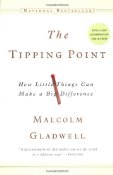
Book Review: The Tipping Point
 Tipping Point is a compelling and interesting book.
Tipping Point is a compelling and interesting book.
Gladwell goes through the various components that lead to epidemics. He investigates the causes and effects of viral cultural shifts, studying things as seemingly disparate as suicide rates, epidemiology, the popularity of Hush Puppy Shoes, or the management organization of Gore Tex.
He breaks things down in terms of the human players and factors that cause movements to “tip”.  According to Gladwell, there are mavens, salesmen, and connectors. Each of whom play a vital role in the spread of an epidemic.
The book opens with an investigation of Paul Revere’s famous ride. Gladwell asserts that Paul Revere is remembered because he was so successful in mobilizing the colonists; much more so than William Dawes, whom nobody remembers today. The reason for Revere’s success stemmed from his ability to mix and interact with key sectors in society. He was a “connector”. Because of his knowledge of who to wake up in the middle of the night, and the fact that he was known to the hitherto slumbering colonists, he was able to rouse resistance much more effectively than Dawes.
The author features an interesting “test” in which a quasi random set of surnames is presented to the reader. He asserts that the number of people you know with names on the list is an eerily accurate determining factor of whether you are or aren’t a “connector”.
Mavens are the second prototypical creatures that Gladwell claims as critical components of an epidemic. A maven is someone absolutely compelled to know all of the ins-and-outs of products. They know what something should be priced, where to get the best deal on something, and feel absolutely compelled to share this information. Many “early adopters” in the technology realm fit this category. These are the folks that can tell you which cell phone you should buy, which microwave, or which car. They thrive on bargain hunting, and consumer research.
The third critical component of an epidemic, according to Gladwell, is the salesman role. These are people with the skills to persuade us when we are skeptical. Somehow they get past our defenses, and relate to us on a level that makes us believe what they say. We can relate. The author dissects the process of communication and comes up with an interesting set of conclusions based on analysis of body language and tone.
Perhaps the most interesting thing in the book (to me) was the discussion of crime in New York. in the mid 90’s. The analysis of cause and effect was very interesting (although Gladwell has since recanted some of his conclusions), and especially how this could be used to turn things around. Gladwell posits that acceptance of deviant behavior in small areas amounts to tacit granting of permission and translated to ever escalating more serious crimes. The evidence is pretty compelling. When the police started cracking down on graffiti, and dodging payment of subway fares (jumping turnstiles, etc), they sent a clear message as to what kinds of behavior were not to be tolerated. It kind of reminded me of the verse “He that is faithful in that which is least is faithful also in much: and he that is unjust in the least is unjust also in much.” By going after the things that were seemingly less significant (than, say murder or assault), the city government was able to remove the perception of tacit approval and hopelessness. Because things looked clean and well maintained, and because an increased police crackdown on fare dodging, overall things improved even in the more violent crime arena.
This portion of the book was not only enlightening but encouraging. It When police in New York began systematically going after fare dodgers and processing them efficiently, they found that they were actually able to identify a lot people with wants and warrants. Consequently, a lot of violent criminals were apprehended. Morale improved in the police department and things got better.
In conclusion, this was a good book. There was a lot of interesting material in it. The two themes that that this reader took away were: It is possible to create an epidemic with a very small number of key people. Likewise, it is possible to stop one. When an epidemic is bad, like crime in New York or the spread of AIDS in Baltimore, this is very heartening to remember.
 The posts are coming!
The posts are coming!


1 comment
Martin – I had previously read this book and also found it interesting how it only requires a few of the right people to create a phenomenon.
[Reply]
Leave a Comment